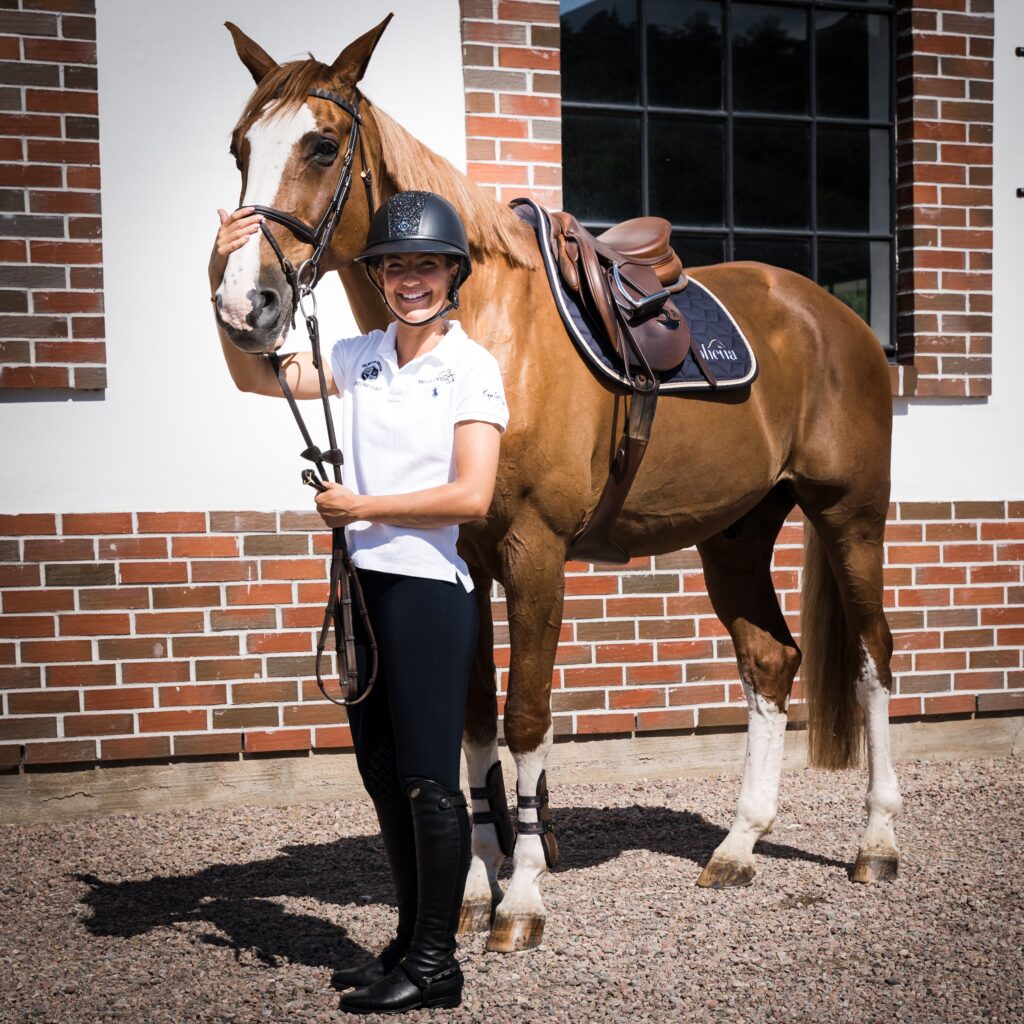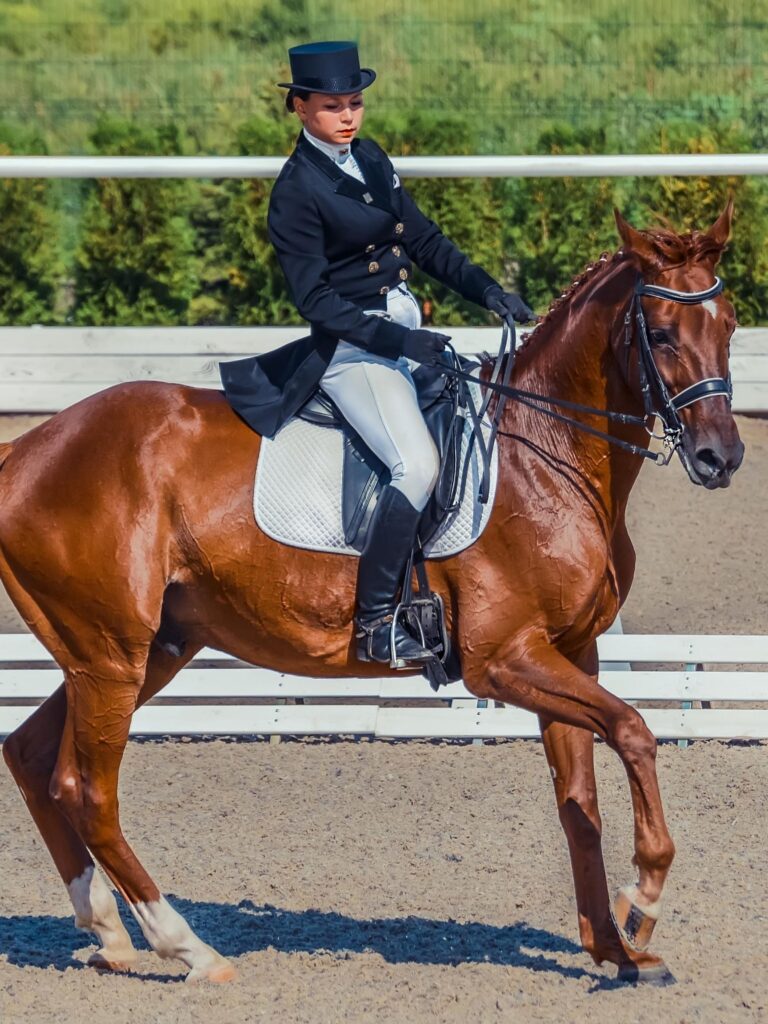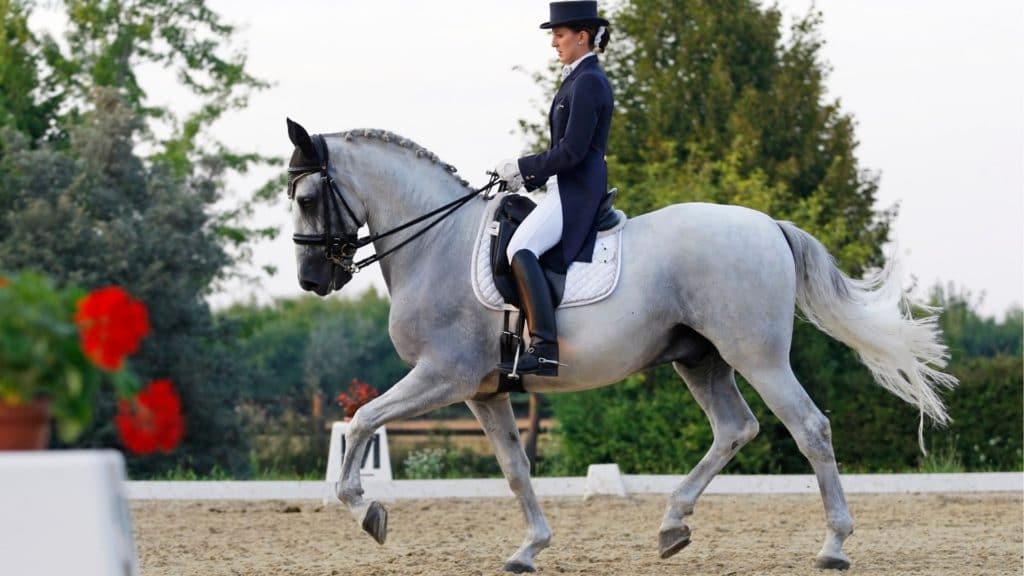
My grandson is a big fan of dressage competitions. He loves the stunning sight of rider and horse in sync, performing before large crowds. Recently he has developed an interest in dressage training, which prompted me to research this topic.
Horses are trained for dressage in a thorough, systemized process that usually starts when they are four years old. With years of proper training, horses and rider develop keen senses of each other and complete difficult movements with minimal cues.
Dressage horses display amazing patience, athletic ability, and intelligence. Traits are appreciated by all who watch the sport, but to get to their level takes a lot of hard work and proper training.

Dressage is a form of equestrian sport that involves training a horse to perform a series of predetermined movements in an elegant and precise manner. It is often referred to as “horse ballet” because of the graceful and controlled movements of the horse.
Dressage involves a series of exercises performed in an arena, with the horse and rider working together to execute the movements accurately and in harmony. These exercises are designed to develop the horse’s balance, obedience, and strength, as well as the rider’s ability to communicate with and control the horse.
Dressage competitions are held at various levels, from local shows to national and international events. At these competitions, judges evaluate the performance of the horse and rider based on their execution of the prescribed movements and the overall harmony and partnership between horse and rider.
Dressage is an important discipline within the equestrian world and is enjoyed by riders and spectators alike. It requires a high level of skill, dedication, and training from both the horse and rider and is a rewarding and challenging sport for those who participate.
If you are a novice at dressage training, this guide will help you understand, and implement, the basics of dressage training, to improve your riding and make it more enjoyable.
You will develop skills to train your horse for dressage competitions. But before we get too deep, let’s start with the basics. Dressage is an equestrian sport with many levels.
It started back in ancient Greek with Xenophon’s writing and is today part of the Olympic Games. Dressage is an art that helps develop a horse’s athletic ability and readiness to perform with the slightest cues.
Through dressage training, horses learn techniques suitable for winning competitions and are useful in many equestrian activities.
Dressage training for high-level competitions is a prolonged process that needs consistent practice for years and requires a rider to be entirely in tune with their horse.
If you want to start dressage training, there are a few things you need to keep in mind.
Horses typically begin dressage training shortly after they turn four years old. However, you don’t want to start with a green broke horse. You must ensure that you break the horse for standard riding before it turns four.
If you wait too long to start riding a horse, they typically have a strong will and are challenging to train.
As someone who wants to start dressage training, you have to develop a bond with your horse. Dressage relies on a deep connection between the rider and the horse. This connection helps the horse perceive and act upon even the rider’s most subtle cues.
To develop the bond, you need to spend time with your horse outside of training, take your horse out walking, lead him by the reins, or go for a pleasure ride. Take the time to groom and bathe him yourself.
Spending time with your horse can help you understand his temperament, and you will build trust with him. This is essential if you want him to respond to your commands later on.
The next steps are to perfect sitting in the saddle and to familiarize yourself with managing reins. Before starting dressage training, you need to master sitting correctly in the, putting your feet through stirrups, and navigating a horse using the reins.
Learn about dressage riding gear and train with the correct equipment to ensure that you are ready for training. Dressage requires certain types of riding gear, so it’s important to work with your horse in an appropriate dressage saddle, bit, and pad.

You need a plan if you want your horse to make consistent improvements. There are two components to dressage training: schooling and conditioning. In schooling, you teach the horse to respond to cues. He learns to walk, trot, canter, and much more.
But equally important is conditioning, which builds up the horse’s physical ability through strength and conditioning exercises so he can perform what you ask of him. With the right mix of the two, your horse will develop the skills it needs to improve consistently and stay healthy.
Your horse should be in shape before you start dressage training. If he isn’t fit and is in poor condition, you’ll need to spend about five to seven months getting him into shape.
You should start with some simple stretching exercises. Get your horse warmed up before doing any stretching. Warming up muscles makes them more pliable and less likely to get damaged. Also, remember to be gentle and not push your horse too far if he shows resistance.
You are still in the trust-building stage, so it’s essential to be receptive to his limits and find a way around them. Thrice a week, make the horse practice neck, back, and leg stretching exercises for 10 to 15 minutes. Gradually increase the duration of the activities.
After a week, start walking with your horse and then riding it. After successive weeks, add short trot sessions and then canter sessions. Once your horse starts building muscle and recovers well from stretching, it’s time to move on to cardio exercises.
Cardio is built up with riding, running, and especially cantering. Cardio sessions help build your horse’s stamina and prevent lactic acid buildup in his muscles. You can plan these sessions 4 to 5 times a week. This phase of training can take anywhere between four to twelve weeks.
It’s important to remember that your horse’s schooling portion will be going on simultaneously with this portion (I will get into the details of that below). Your horse should be settling into the correct posture, adequately stretching his back, and pushing forward with his hind legs.
Reducing the number of cardio days to one, you should give two days to strength-building now. Some strengthening exercises you can use are jumping fences, cantering uphill and then walking back downhill, repeated trotting in circles, etc.
After demanding exercise days, give your horse some easy workdays. Slowly increase the interval and intensity of exercises until your horse reaches the desired physical ability.
Dressage training requires that your horse become accustomed to the natural aids you use to communicate with him. Ideally, the smallest cue should be enough for the horse to understand what you want. However, it takes years for horses to get to that level.
Initially, the cues you give to your horse using your body will have to be pronounced. Your horse will struggle to understand what you want him to do. With time, however, this process will become smooth.
You will teach your horse multiple movements like walk, trot, canter, circle, half-circles, or straight lines, and more. The horse will take time to digest and learn to do each activity based on the cues you give him.
It’s best to be consistent with your riding and aids to help the horse understand you better. Don’t get angry or frustrated when the horse doesn’t get something right. Instead, break down processes into smaller parts so that he gets a more precise understanding of what you are asking of him.
The best way to train horses is to use negative reinforcement. That means you remove a stimulus after obtaining the desired result. For example, you apply pressure to the horse using your legs and seat bones, and when the horse moves in the desired direction, the pressure is removed.
Every day, your horse will have a workout session consisting of three parts: warm-up, training/body of workout, and cool-down. The warm-up phase is simple. It can include walking or riding. The only purpose is to get the horse ready for the training phase.
When your horse has become alert and responsive, the training phase of the workout begins. Using basic natural aids, you get the horse to do a set of movements, from a trot and a canter to moving along straight lines, circles, and half-circles.
After the horse understands what movements are required of him, you can slowly increase the workouts’ duration and start incorporating more exercises. The training phase is the most challenging phase of the workout, as it consistently challenges the horse’s limits. Be sure not to push your horse too hard.
The last phase of training is a cool-down phase. In this phase, get your horse to do the things he finds easy and enjoyable, and then finish off with a simple walk. Over time, your horse will learn that an easy/enjoyable activity always rewards difficult ones, which will help him push through the more demanding tasks.

While you are schooling your horse, there are some principles that you can use as a guide, mainly: rhythm, suppleness, contact, impulsion, straightness, and collection. These are called the Pyramid of Training and are given by the United States Dressage Federation.
A horse will progress through each pyramid level with time, starting from rhythm and ending at collection.
Rhythm stands for regularity and tempo in the horse’s gait. Your training should serve to make the walk, trot, and canter of the horse pure so the horse achieves balance.
Suppleness means elasticity and freedom from anxiety. Your horse should not be mentally or physically tense but should be moving with elasticity and flexibility.
Contact means that the horse is receptive to the rider’s aid and accepts the bit.
Impulsion is the desire to move forward. You can measure it through the length of the horse’s stride and the suspension period in a trot or a canter.
Straightness stands for the symmetry and improved alignment of the horse.
Collection is the lightness of the gait of a horse because of the thorough engagement of the hindlegs. Collection occurs after a horse has mastered rhythm, suppleness, contact, straightness, and impulsion. Novice dressage horses aren’t expected to master it.
Keep the six training scales in mind when schooling your horse, and try to achieve them one by one.
Following my listed steps, you can train your horse for dressage effectively. It will vastly improve your riding experience and also enable your horse to enter amateur dressage competitions.
If you want detailed basic dressage exercises and horses, I recommend you go through the following pdf provided by USDF.
A good dressage horse typically exhibits balance, agility, and strength, with a willingness to learn and respond to rider cues. It should have a smooth, rhythmic gait, strong hindquarters for powerful movement, and a natural ability to collect and extend. A calm, attentive temperament and a strong bond with the rider are also important.
The best horse breed for dressage often depends on the rider’s preference and level of competition. Warmblood breeds, particularly the Hanoverian, Dutch Warmblood, and Oldenburg are among the most common in high-level dressage due to their strength, agility, and temperament. However, many other breeds, including Thoroughbreds, Andalusians, and Lusitanos, can also excel in this discipline.
Dressage involves potential risks such as falls, which can lead to injuries ranging from minor to severe. Incorrect training methods can cause physical or psychological stress in horses. Overtraining or pushing a horse beyond its capability can result in health issues. Adherence to safety protocols and proper training methods helps minimize these dangers.